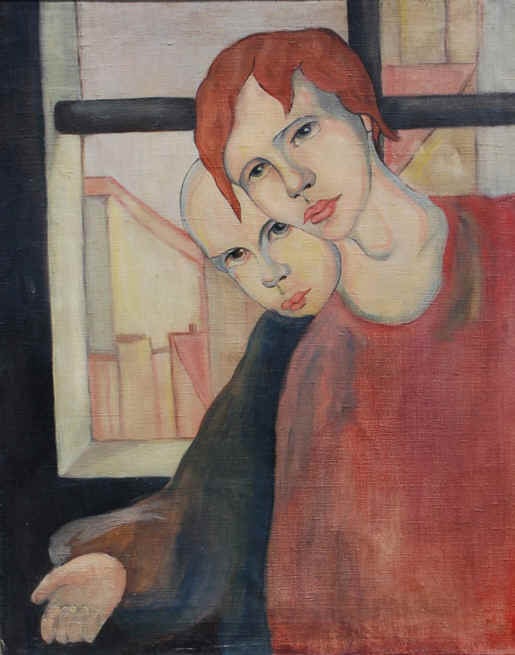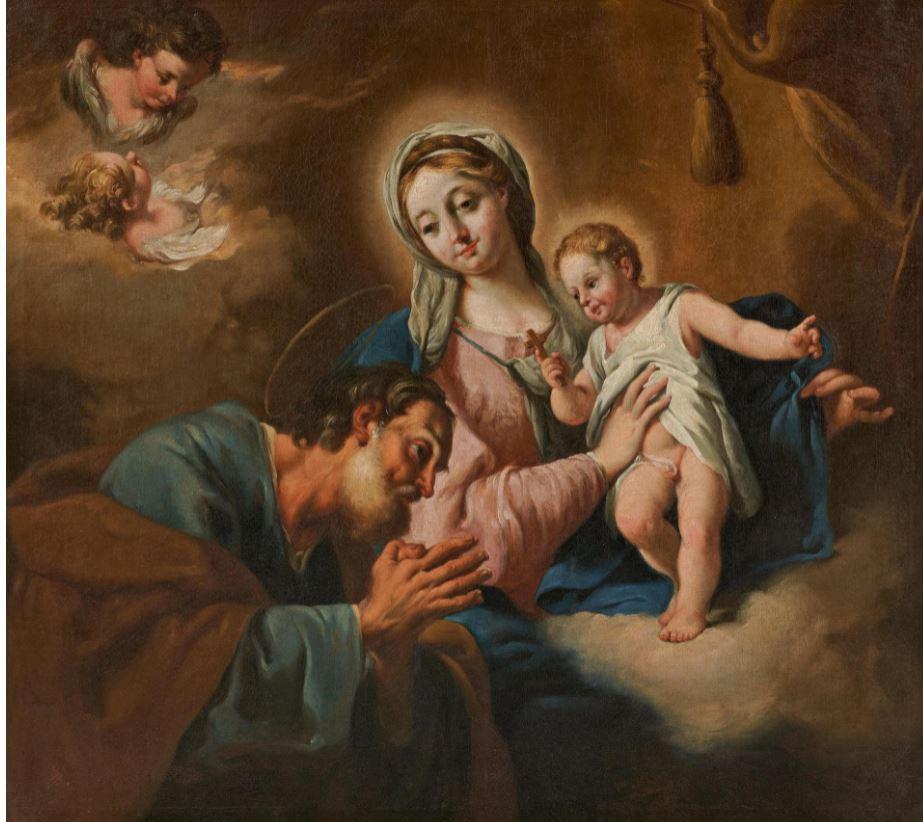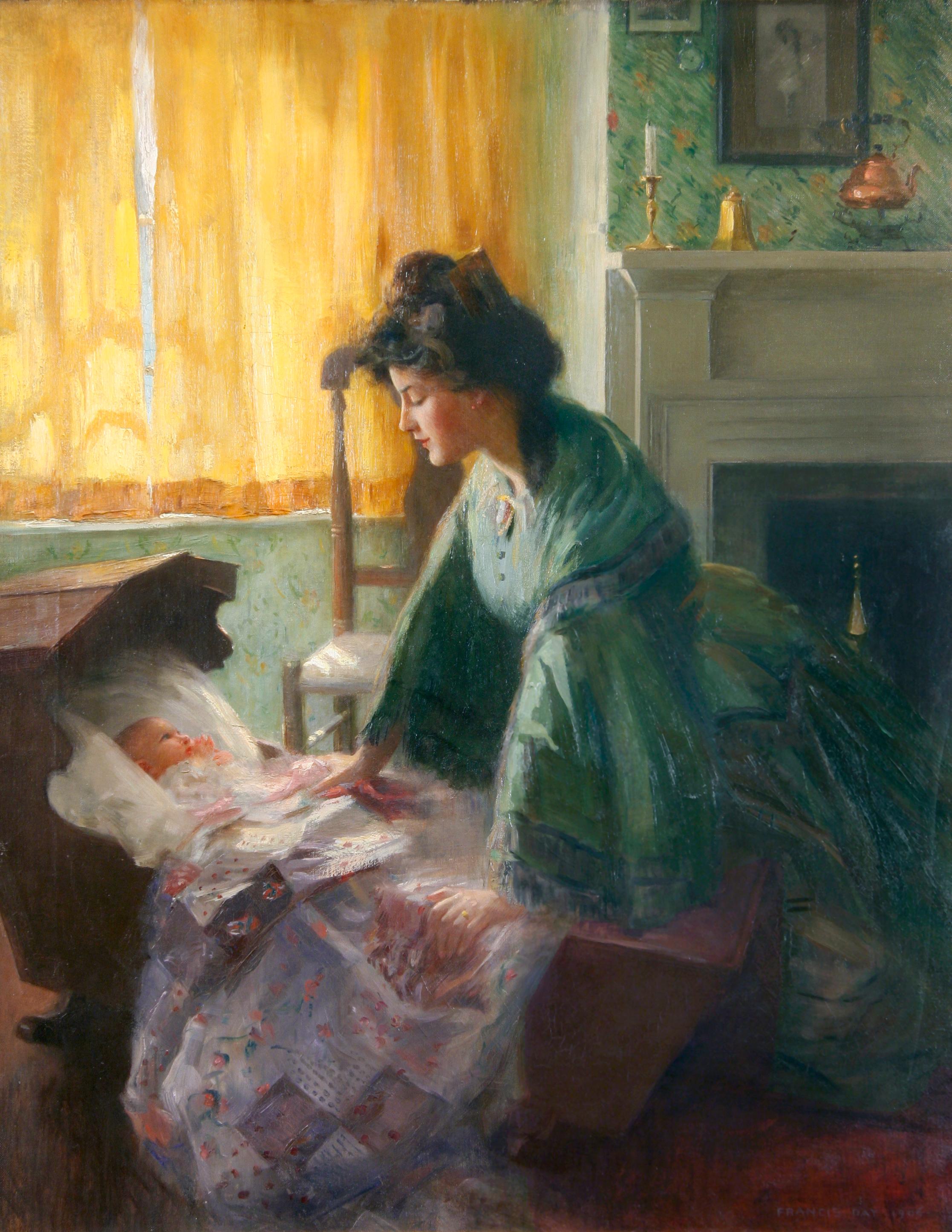Items Similar to "A Reverie During The Ball", 19th Century Oil on Canvas by Rogelio Egusquiza
Want more images or videos?
Request additional images or videos from the seller
1 of 17
Rogelio de Egusquiza y Barrena"A Reverie During The Ball", 19th Century Oil on Canvas by Rogelio Egusquiza1879
1879
About the Item
ROGELIO DE EGUSQUIZA
Spanish, 1845 - 1915
A REVERIE DURING THE BALL
signed and dated "Rogelio Egusquiza, 1879" (lower right)
oil on canvas
21-3/4 X 33-5/8 inches (55 X 85cm.)
framed: 28-1/4 X 40-1/4 inches (71.5 X 102 cm.)
PROVENANCE
Bonham´s London - Sale date 13th November 2007.
Private Spanish Collector
An intimate work by Rogelio de Egusquiza, dated in 1879 that corresponds to the time when Egusquiza breaks with his previous way of painting and begins a stage with large-format works and all related to music, and more specifically with Wargner.
In the foreground of the work we see a female figure with an attitude of repose, painted with exquisite delicacy, bathed all of it with a warm indirect light.
Rogelio de Egusquiza y Barrena (Santander, 1 1845-Madrid, February 10, 1915) was a Spanish painter, sculptor and engraver, especially known for being a friend of the German composer Richard Wagner, having made Wagnerian-themed paintings, and contributing to the dissemination of its aesthetics in Madrid.
He trained in Madrid and at the Imperial School of Fine Arts in Paris. From the late 1860s, he resided in Paris. The theme of his works was in this historicist era. Subsequently, he made genre painting and portraits, and all in an academic style.
After the death of Mariano Fortuny, he was in his workshop in Rome, working with the Madrazo, Raimundo and Ricardo, until 1875.
He met Wagner's music in 1876, while in Paris, which led him to travel to Munich to listen to The Nibelungo Ring in 1879. His enthusiasm for the music and aesthetic ideas of this composer led him to know him personally, for what went to his house in Bayreuth. In later years, he met the composer several times: Venice, 1880; Berlin, 1881 and Bayreuth, 1882. On this last occasion, he attended the premiere of Parsifal. He is one of the only two Spanish friends that Wagner had; the other was the music critic Joaquín Marsillach.
From his encounter with Wagner, Egusquiza took a turn to his career and devoted himself to painting Wagnerian themes, more portraits of his characters than concrete scenes, in a symbolist style. And also portraits, like that of Schopenhauer and Louis II of Bavaria. He was the only Spaniard, apart from Dr. José de Letamendi, who collaborated in the magazine Bayreuther Blätter, with an article on lighting in the theater, entitled «Ueber die Beleuchtung der
He participated in the Rosicrucian salons of 1892, 1893, 1896 and 1897. He presented prints on Parsifal (Kundry, Amfortas, Parsifal, Titurel and The Holy Grail) at the Universal Exhibition of Paris in 1900, where he was recognized with a medal silver; He was part of the Aureliano de Beruete jury.3 The French government distinguished him with the Legion of Honor.
Although he lived in Paris, he frequently traveled to Madrid, where his sister lived. He joined the Madrid Wagnerian circle, around the Lhardy restaurant. With his painting, he influenced the reception of Wagnerism in the capital. As Paloma Ortiz de Urbina y Sobrino points out:
It conserves works of Egusquiza, mainly, the Museum of the Prado, having some in the National Library of Madrid, and in the Museum of Modern and Contemporary Art of Santander and Cantabria. In addition to drawings and prints, the Prado Museum preserves a bronze bust of Richard Wagner (1892).
To celebrate the second centenary of Wagner's birth, the Prado exhibited, between November 5, 2013 and September 7, 2014, works by Egusquiza, in room 60 of the Villanueva building, with the title "Evil vanishes" .
EXHIBITED
Fundación MAPFRE , Madrid
Sala Recoletos
19 Septiembre 2019 - 12 Enero 2020
"El espíritu de una época BOLDINI y la pintura española a finales del siglo XIX", page 226, illustrated
- Creator:Rogelio de Egusquiza y Barrena (1845 - 1915)
- Creation Year:1879
- Dimensions:Height: 21.66 in (55 cm)Width: 33.47 in (85 cm)
- More Editions & Sizes:55 x 85 cm.Price: $61,028
- Medium:
- Movement & Style:
- Period:
- Condition:
- Gallery Location:Madrid, ES
- Reference Number:1stDibs: LU128115607371
About the Seller
5.0
Vetted Seller
These experienced sellers undergo a comprehensive evaluation by our team of in-house experts.
Established in 1977
1stDibs seller since 2019
21 sales on 1stDibs
Typical response time: 2 hours
- ShippingRetrieving quote...Ships From: Madrid, Spain
- Return PolicyA return for this item may be initiated within 14 days of delivery.
More From This SellerView All
- "Wedding Ceremony in Tebriz", 19th Century Oil on Canvas by Mohamed Ali NaqashLocated in Madrid, ESMOHAMED ALI NAQASH Iraqi, 19th - 20th Century WEDDING CEREMONY IN TEBRIZ signed in arabic and inscribed Mohamed Ali al-Naqash / Tabrizi lower right oil on c...Category
Early 1900s Realist Figurative Paintings
MaterialsOil, Canvas
- "The Florence Sisters", 19th Century Oil on Canvas, Spanish Artist José VillegasLocated in Madrid, ESJOSÉ VILLEGAS Y CORDERO Spanish 1844 - 1921 "The Florence Sisters" signed "Villegas" (lower left) oil on canvas 33-1/2 X 40-1/2 inches (84.5 X 102.5 cm.) PROVENANCE Private Collector, Seville, Spain José Villegas Cordero (Seville, August 26, 1844-Madrid, November 9, 1921) was a Spanish painter. He directed the Prado Museum between 1901 and 1918. Biography He was the brother of the painter Ricardo Villegas Cordero. He began his apprenticeship very young with José María Romero, with whom he remained for two years until entering the School of Fine Arts in Seville, where he was under the tutelage of Eduardo Cano. In 1860, when he was only 16 years old, he sold his work Little Philosophy for 2,000 reais at the Seville Exhibition. In 1867 he traveled to Madrid, where he entered Federico Madrazo's studio. There he established friendship with painters Eduardo Rosales and Fortuny. He went regularly to the Prado where he copied Velázquez, from whom he acquired spontaneity and the use of color for his technique. Finally, and out of admiration for Fortuny's orientalist painting, he returned to Seville and organized an excursion to Morocco. At the end of 1868 he decided to travel to Rome accompanied by the painters Rafael Peralta and Luis Jiménez Aranda...Category
Late 19th Century Realist Figurative Paintings
MaterialsCanvas, Oil
- PaddockBy Emilio Grau SalaLocated in Madrid, ESEMILIO GRAU SALA Spanish, 1911 - 1975 PADDOCK signed "Grau Sala" (lower right) oil on canvas 21-1/3 x 25-1/2 inches (54 x 65 cm.) framed: 27-1/2 x 32 inches (70 x 81 cm.) PROVENANCE...Category
1960s Post-Impressionist Figurative Paintings
MaterialsCanvas, Oil
- "Conversando", 19th Century Oil on Canvas by Artsit Ángel María CortelliniLocated in Madrid, ESÁNGEL MARÍA CORTELLINI Spanish, 1819 - 1887 CONVERSANDO signed "Cortellini" (lower right) oil on canvas 13-1/4 x 11 inches (33.5 x 28 cm.) framed: 17-1/4 x 15 (44 x 38 cm.) Ángel María Cortellini. Sanlúcar de Barrameda (Cádiz), 27.09.1819 – Madrid, 1887. Painter. Ángel María Cortellini was born in Sanlúcar de Barrameda on September 27, 1819, to an Italian father and a Spanish and Sanlúcar mother. Contrary to family opinion, he decided to dedicate himself to painting and already, at the age of nine, he was enrolled in a drawing academy in his hometown. They soon sent him to Seville, where he was a disciple of Joaquín Domínguez Bécquer...Category
19th Century Romantic Figurative Paintings
MaterialsCanvas, Oil
- "Ofreciendo una copa", 19th Century Oil on Canvas by Ángel María CortelliniLocated in Madrid, ESÁNGEL MARÍA CORTELLINI Spanish, 1819 - 1887 OFRECIENDO UNA COPA oil on canvas 13-1/4 x 11 inches (33.5 x 28 cm.) framed: 17-1/4 x 15 (44 x 38 cm.) Ángel María Cortellini. Sanlúcar de Barrameda (Cádiz), 27.09.1819 – Madrid, 1887. Painter. Ángel María Cortellini was born in Sanlúcar de Barrameda on September 27, 1819, to an Italian father and a Spanish and Sanlúcar mother. Contrary to family opinion, he decided to dedicate himself to painting and already, at the age of nine, he was enrolled in a drawing academy in his hometown. They soon sent him to Seville, where he was a disciple of Joaquín Domínguez Bécquer...Category
19th Century Romantic Figurative Paintings
MaterialsCanvas, Oil
- "Partida de Tresillo", Late 19th Century Oil on Canvas by José Jiménez ArandaLocated in Madrid, ESJOSÉ JIMÉNEZ ARANDA Spanish, 1837 - 1903 PARTIDA DE TRESILLO signed, located & dated “J. Aranda / Madrid. 1893.” (lower right) oil on canvas 31-1/2 x 39-1/3 inches (80 x 100 cm) framed: 40-1/3 x 48 inches (102.5 x 122 cm.) BIBLIOGRAPHY - This picture being mentioned and illustrated in “LA ILUSTRACION ESPAÑOLA Y AMERICANA”, Madrid, September 15, 1895 - José Jiménez Aranda, 1837-1903: Centro Cultural El Monte, Seville, October 2005, illustrated p. 102 PROVENANCE Private Collection, USA José Jiménez Aranda (7 February 1837 – 6 May 1903) was a Spanish painter and brother of the painters Luis Jiménez...Category
1890s Realist Figurative Paintings
MaterialsOil, Canvas
You May Also Like
- DedaleBy Jan Frans DeboeverLocated in West Hollywood, CABelgian Symbolist artist Jan Frans DeBoever (1872 - 1948), created symbolist/allegorical paintings throughout his lifetime. He centralized on allegorical and literary subjects, gener...Category
1920s Symbolist Figurative Paintings
MaterialsPanel, Oil
- Mid 20th Century French Symbolist Oil St. Francis of Assisi in Garden, signedLocated in Cirencester, GloucestershireArtist/ School: French School, mid 20th century, artists details to reverse. Title: St. Francis of Assisi, painted in a Symbolist style. Medium: oil on board, framed Framed: 27...Category
Mid-20th Century Symbolist Figurative Paintings
MaterialsOil
- The BrothersBy Gertrude KlarisLocated in West Hollywood, CAAn original oil on canvas by Hungarian artist Gertrude Klaris. Klaris worked in oils but pramrily in mixed media works on paper, much of her style is akin to her love of stained glas...Category
1910s Symbolist Figurative Paintings
- HOMAGE TO THE CLASSICSBy Ferjo, Fernando de Jesus OliveiraLocated in Aventura, FLOriginal oil painting on canvas. Hand signed on front by the artist. Canvas is stretched. Artwork is in excellent condition. Certificate of authenticity included. All reasonable...Category
21st Century and Contemporary Surrealist Figurative Paintings
MaterialsCanvas, Oil
- Giovanni Battista Pittoni, Holy Family with Cupids, Venetian Baroque, ChristmasBy Giovanni Battista PittoniLocated in Greven, DEIn 2001 the German art historian Art historian and Raphael Expert, Prof. Jürg Meyer zur Capellen, published the painting "Die Heilige Familie" in a monographic article, ascribing the present work to the Venetian painter Giovanni Battista Pittoni (1687 -Venice - 1767). (Newspaper "Weltkunst", October 2001, No 12, p. 1850 f. ill.) He describes it as a typical work by this artist. Pittoni was one of the most influential and successful artists of the Venetian Settecento. He was a pupil of the Veronese Master Giovanni Balestra (1666-1740). His style is influenced by Sebastiano Ricci (1659-1734) and Giambattista Tiepolo (1696-1770). Giovanni Battista Pittoni was already successful at a young age and soon lead his own workshop. He created large-scale hitoria paintings, as well as large, religious altarpieces. In addition to Venetian and Upper Italian patrons, Pittoni also had many interested parties from Europe. His work is accordingly scattered in many different museums and private collections today. Pittoni - like other painter colleagues of his time - repeated his own compositions both by hand and with the help of his workshop. He repeatedly incorporated details into other pictures and contexts. Prof. Meyer zur Capellen noted the very good condition of the present work and the high quality of the paint with fine graduations and the vivid brushstrokes. Provenance: The panting has not been on the art market for at least 300 years. In the year 2000 the work was donated by the Münster-based, Noble Family Ketteler zu Harkotten to a private collection in Westphalia. Most probably the canon Nikolaus Hermann von Ketteler zu Harkotten bought the piece in Venice in 1750 together with the altarpiece of the Clemens Church in Münster. On the reverse of the work is a fideicommissum number by Ketteler zu Harkotten. As it belonged to the family commission, the painting was inalienable until 1919, when the corresponding law was repealed, and after that time it remained in the family's possession without interruption. Pittoni's only direct relationship to Münster is the commission for the high altar painting of the Baroque St. Clemens Church. It can be assumed that then canon von Ketteler saw this painting in the artist's workshop during his stay in Venice and acquired it for himself. This would also explain the discrepancy in dating. (ca. 1735/1750). However, it is also possible that the painting originated in the possession of Ferdinand von Plettenberg...Category
Early 18th Century Rococo Figurative Paintings
MaterialsCanvas, Oil
- Light of LoveLocated in Washington, DCExhibited: National Academy of Design, New York, 1906 (as no. 101) Art Institute of Chicago, 1908 (as no. 74)Category
Early 1900s American Realist Figurative Paintings
MaterialsCanvas, Oil
Recently Viewed
View AllMore Ways To Browse
Antiques On Sale
Art 13th Century
Oil On Canvas Venice Scene
German 19th Century Oil Canvas
Large German 19th Century Painting
Paintings 19th Century Room In Paris
Signed Wagner
19th Century Spanish Light
Venice Oil 19th Century
Painting Bonhams
Wagner Germany
Modern Painting 40 X 60
Fortuny Paintings
Silver Ball Ring
Oil Portrait 1900s
Signed Wagner Painting
Oil Painting Xix
Spaniard Painting





